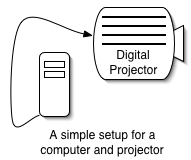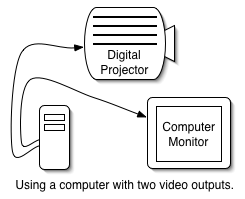Service Video Display
As culture becomes more media oriented, many churches are looking for ways to use visual elements to enhance their worship service. What started as simple transparency with song lyrics has grown into projectors and computer systems that allow the congregation to view scriptures and song lyrics on large screens as part of the worship experience.
Song Lyrics
There are several ways to project your song lyrics during a service. They are listed here in the approximate order from least expensive to most expensive. We'll assume that you have some system in place to project from a computer. More information about digital projectors can be found in the appendix.
PowerPoint
The simplest solution is to type your lyrics into PowerPoint and show them during the service. When PowerPoint is running full screen you can move forward and backwards through the slides using the page up and page down keys.

While this type of setup is simple, it can be very difficult to jump around when the worship team changes to a different section of the song, or changes the song order. The best way to get around this is to print out thumbnails of all your slides with the slide numbers before the service. By typing in the slide number you can jump directly to that slide instead of only moving up or down through the list.
If you have a computer with more than one video output, you can display the slideshow through one output, but keep the thumbnails of all the slides visible in the other. This means you can show the full slide on a projector while viewing all the small slides on a computer screen. Using a mouse you can select which slide you want to display on the large screen by clicking on it.

While PowerPoint can be a good simple solution, most churches end up switching to software made specifically for song lyrics.
Song Screen
Song Screen is a program for displaying lyrics, scriptures, video clips and announcements. It is made specifically for churches. It has a good search feature that lets the operator quickly find songs even if they weren't the songs that were planned.
Song Screen needs two video outputs. One displays the controls that allow you to select which song and which section of the song you wish to display. The other hooks to the display for the congregation.
You can get more information about the current version of Song Screen from www.songscreen.com.
Media Shout
Media Shout is another presentation software package that is made specifically to meet the needs of the church. It is geared for working with video clips and other types of media.
One of the key features of Media Shout is the fact that it can show a moving background behind your lyrics. To get moving backgrounds with some of the other products you will need another output from a computer and a special type of mixing unit that superimposes the lyrics on the background. Information about the current version of MediaShout can be found at www.mediashout.com.
Scriptures
Most of the software that can be used for displaying song lyrics can also be used for scriptures. If you know ahead of time what scriptures will be used during a service, it is easy to type them into PowerPoint. You can also copy and paste them from Bible software or an online Bible such as www.biblegateway.com.
If you don't know what scriptures are going to be used, you will need a way to quickly locate and display the necessary scriptures. Both SongScreen and MediaShout have the ability to lookup scriptures on the fly. SongScreen (www.songscreen.com) comes with the KJV and you can order other translations. MediaShout (www.mediashout.com) comes with 19 translations.
Sermon Outline
Using your displays to show the speakers outline helps people focus on the sermon because it visually reinforces what is being said audibly. The easiest way to create outlines for presentations is with presentation software such as PowerPoint for Windows or Keynote for OS X.
Presentations can be controlled from the computer (usually in the sound booth) or remotely by the person speaking. There are many different types of wireless remote control products available, but they generally fall into two categories�Radio Frequency and Infrared.
Infrared Remote Controls
Infrared remotes are similar to what comes with a TV or VCR. The remote sends a signal encoded in invisible light. The receiver picks up the signal and then executes the command. Since the signal uses light, it tends to only work line of sight and it is usually only reliable at less than 30 feet. The useable distance depends on the particular remote and some will work at a much greater range.
Many digital projectors come with this type of remote built into them. A small cable runs from the projector to the computer to pass on any commands received by the projector's receiver.
Infrared remotes are usually less expensive than their Radio Frequency counterparts, so they are a good choice if you don't need a long range. However for many sanctuaries the distance will require a different solution.
Radio Frequency Remote Controls
Radio Frequency Remotes use radio waves to send control messages. Since radio waves don't need to be line of sight, they can be used over larger distances. The exact distance varies from model to model.
These type of remotes are usually more expensive, but to control a presentation from the front of a large sanctuary, they may be the only option.
You can find a variety of remote control products on the internet, by searching for the terms "wireless presentation remotes".
Be careful if you are giving the speaker a remote control with a pointer. Once we gave someone a remote that included the ability to move the mouse on the display computer. We explained that he shouldn't use the joystick pad, but should only click the button when he wanted to advance to the next slide. Unfortunately he couldn't resist playing with the button. During the worship service he unknowingly jumped the pointer all over the screen making it very difficult for the graphics operator to display the song lyrics correctly.